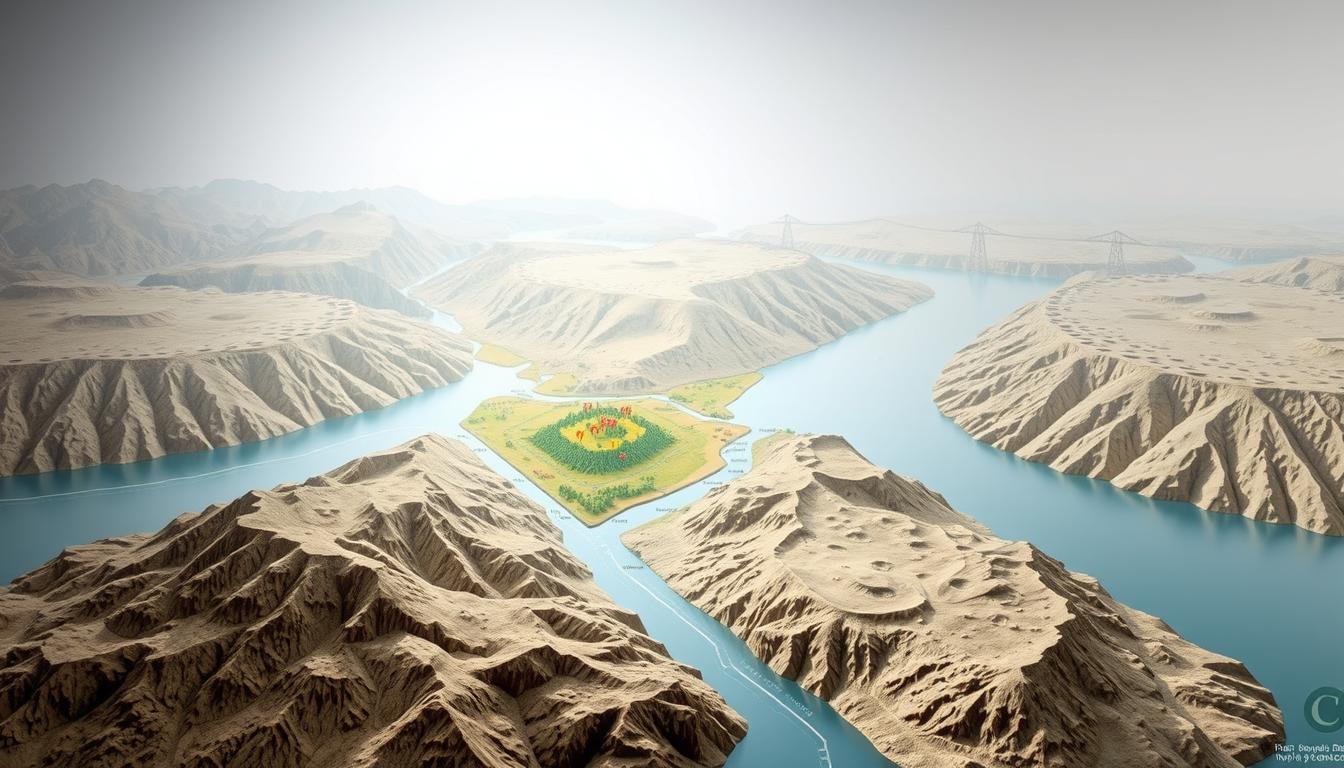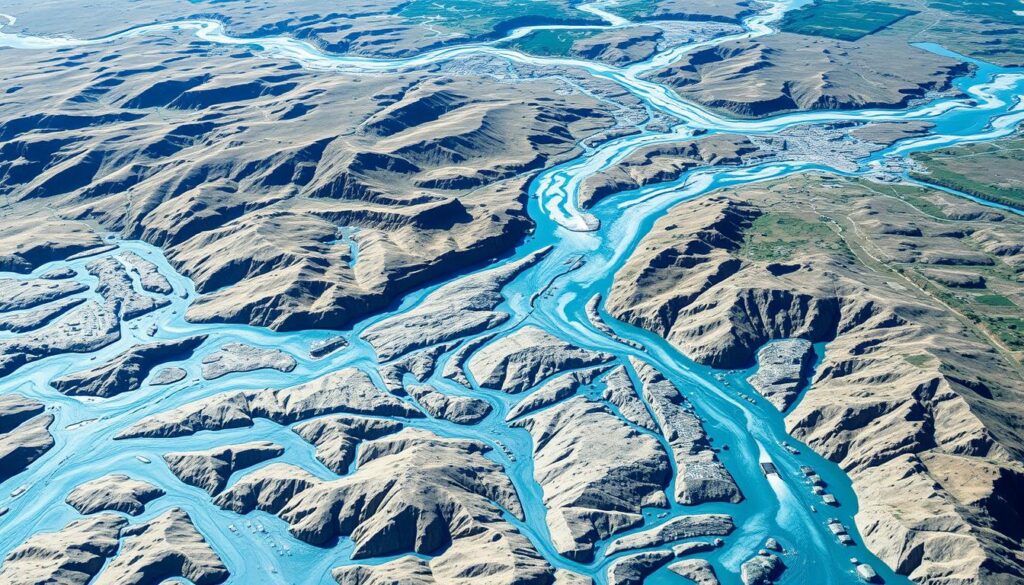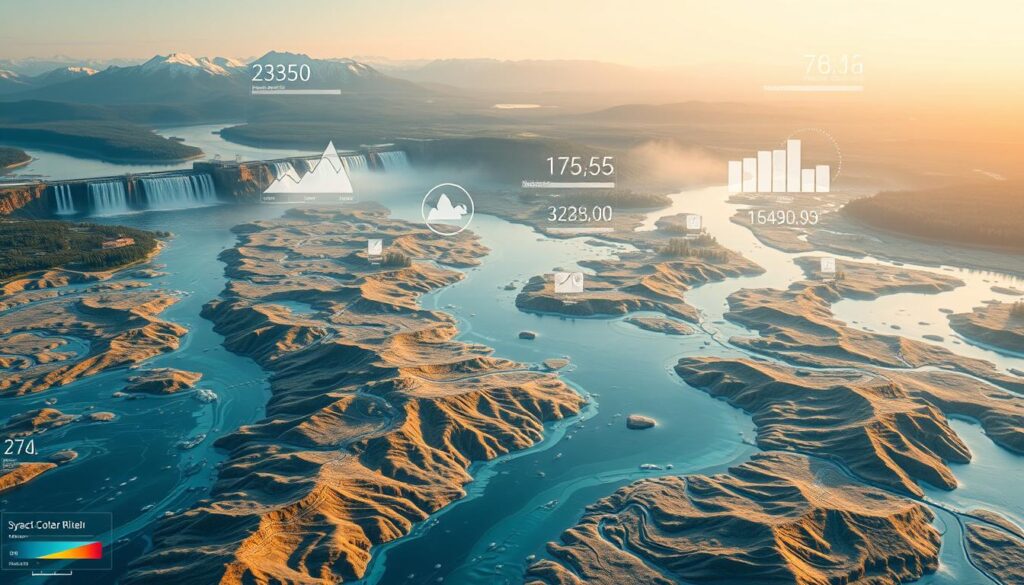
Thinking about the future of energy? Wondering how to use water to make electricity? Hydropower maps are key to finding clean energy. They show where energy can be made, helping us find the best spots and make more energy.
Hydropower uses water to make electricity. In the U.S., it’s the biggest source of renewable electricity. By looking at hydropower maps, you can see where hydroelectric power can be made. This helps us move towards a greener future.
Table of Contents
Introduction to Hydropower Maps
Hydroelectric power maps are crucial for finding places to make hydroelectric power. They give a clear view of energy resources. This helps us spot areas with lots of energy potential.
Key Takeaways
- Hydropower maps are a valuable tool in discovering clean energy potential
- Hydroelectric power maps provide a visual representation of energy resources
- Hydro energy maps help identify areas with high energy potential
- Renewable energy maps contribute to a more sustainable future
- Hydropower is the largest source of renewable electricity in the United States
- Hydropower maps are essential for identifying potential sites for hydroelectric power generation

Understanding Hydropower Maps and Their Significance
When you dive into clean energy, you’ll see hydropower maps. They’re key for finding places with lots of energy potential. These maps come from hydro mapping and hydrology mapping. They study water flow, elevation, and geology to find the best spots for hydropower.
By looking at these factors, you learn more about a region’s energy resources. This helps you understand what’s available in different areas.
Hydropower maps show water flow, elevation, and geology. They’re vital for making the most of energy production. The main parts of hydroelectric power mapping are:
- Water flow data, which shows areas with lots of energy potential
- Elevation data, which tells us how much power can be made
- Geology data, which tells us about the rock formations and how they affect water flow
Using water power maps for planning has many benefits. It helps find areas with lots of energy, makes energy production better, and reduces environmental harm. By using hydropower resources and hydro mapping tech, you can make smart energy choices. This helps create a greener future.
How to Read and Interpret Hydropower Maps
To understand hydropower maps, you need to know the data behind them. Look for water flow and elevation, key for finding hydroelectric sites. These maps show where water power can be harnessed.
When looking at hydropower maps, think about geology and the environment. This helps in planning hydroelectric projects. A water power map shows where water and energy can be found.
Here are steps to follow when reading hydropower maps:
- Identify the scale and legend of the map to understand the symbols and colors used.
- Look for areas with high water flow and suitable elevation, which are ideal for hydroelectric power generation.
- Consider the geology of the area, including the type of rocks and soil, to determine the feasibility of a hydroelectric project.
- Assess the environmental impact of a potential hydroelectric project, including the effects on local ecosystems and wildlife.
By following these steps and using a hydroelectric power map, you can better understand hydroelectric potential. This helps in making smart energy project decisions.
Interactive Tools and Resources for Hydro Energy Mapping
Exploring hydro energy mapping opens up a world of interactive tools and resources. These tools help you see energy resources, find high energy areas, and boost energy production. A renewable energy map is key, giving a full view of the energy scene.
Platforms like hydropower potential map services let you check energy potential in places. They have tools for data, mapping, and analysis. For instance, a hydroelectricity map shows where hydroelectric power works best.
Popular Hydropower Mapping Platforms
- National Renewable Energy Laboratory (NREL)
- International Hydropower Association (IHA)
- World Energy Council (WEC)
Government Resources for Hydroelectric Data
Governments worldwide share hydroelectric data and maps. These help shape energy policies, spot development spots, and improve energy use.
Analyzing Your Region’s Hydroelectric Potential
To figure out your region’s hydroelectric potential, you need to look at the data and see the energy resources. A hydro map is key, showing the area’s water and energy potential. It helps spot important details like water flow and height, vital for planning a hydropower project.
When checking your region’s hydroelectric potential, think about geology and the environment. A water energy map shows how these factors work together. It helps find the best places for hydropower, making your energy mix greener and cutting down on fossil fuel use.
Here are some steps to analyze your region’s hydroelectric potential:
- Use a hydro map to find areas with lots of water flow and good height.
- Look at the area’s geology to see if a hydropower plant can be built.
- Check how a hydropower project might affect the local environment.
By studying these factors and using tools like hydro and water energy maps, you can tap into your region’s hydroelectric power. This helps make the future energy mix more sustainable. Always think about the links between geology, environment, and hydropower to develop your resources wisely.

Conclusion: Harnessing the Future of Clean Energy Through Mapping
Hydropower maps are key to unlocking clean, renewable energy. They help us see where we can best use hydroelectric power. This way, we can make smart choices to boost energy production.
These maps give us lots of data. They help us figure out our area’s hydroelectric potential. They also guide us in planning for the future of energy.
Using hydropower maps is a step towards a greener energy future. They give us the tools to make informed decisions. This leads to a more sustainable and resilient energy landscape.
Let hydropower maps lead the way to a cleaner energy future. With these maps, you can make strategic decisions. This will help create a brighter, more sustainable tomorrow.
FAQ
What are hydropower maps and why are they important?
Hydropower maps show where hydroelectric power can be made. They help find the best places for power generation. This is key for using renewable energy wisely.
What kind of information do hydropower maps typically include?
These maps show water flow, elevation, and geological data. This helps figure out where to make hydroelectric power.
How can I read and interpret hydropower maps?
To understand these maps, you need to know the data behind them. Look at water flow, elevation, and geology. Also, think about the environment and laws when looking at hydroelectric potential.
What interactive tools and resources are available for hydropower mapping?
Many tools and resources are out there. Online platforms, government databases, and GIS software are some examples. They help you see energy resources and find the best places for power.
How can I analyze the hydroelectric potential of my region?
To figure out your region’s hydroelectric potential, check the water flow, elevation, and geology. You can use online tools and government resources for this. Also, keep in mind the environment and laws in your area.
